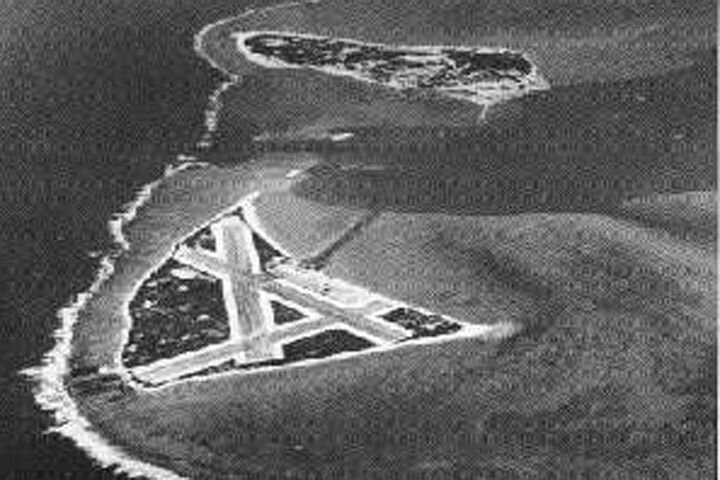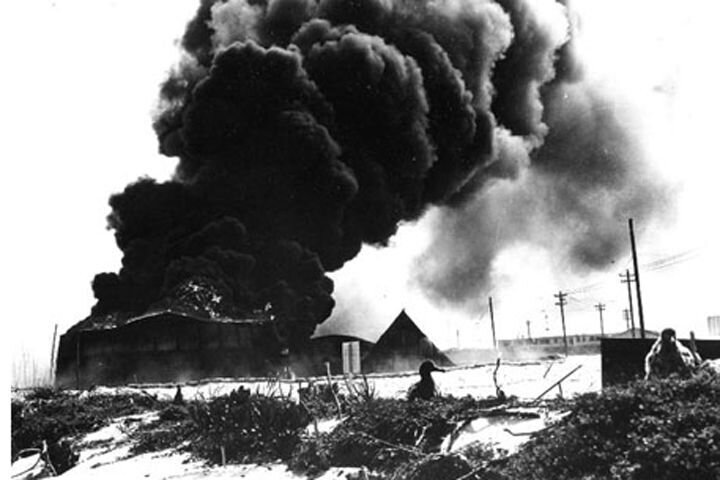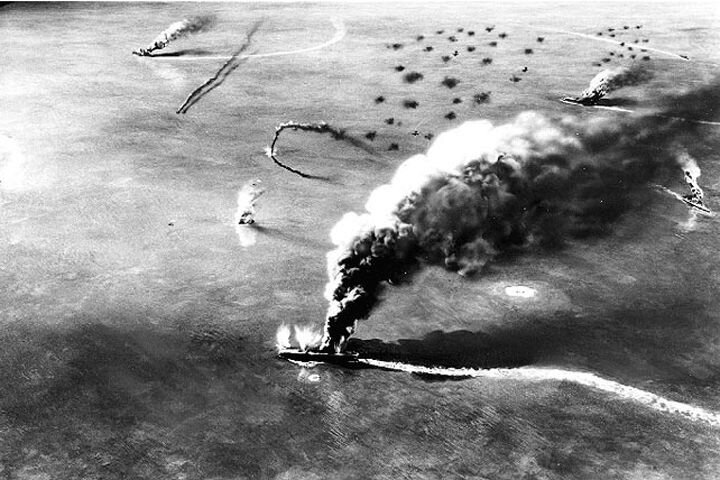Was Midway a Miracle?
Midway opened in theaters this weekend. It is a major war film named after one of the most important naval battles in history. It is also opening less than a month after researchers in the real world have discovered two of the immense warships that sank in that battle.
Here is the who, what, when and where of the Battle of Midway. You decide the how and the why.
The worst war ever is underway. One way or the other, history is about to change forever. The world’s most powerful nations are at war, or are about to be. Over the past year and a half, Germany has conquered Poland, Denmark, Norway, Belgium, the Netherlands, Luxembourg, France, Yugoslavia and Greece, and Britain alone is fighting for its survival. The Soviet Union is uncommitted but helping Germany, and the United States is uncommitted but helping Britain.
The last major power is the Empire of Japan. Over the past year and a half, it has conquered French Indochina (Vietnam, Cambodia and Laos), the Dutch East Indies (Indonesia), Burma (Myanmar), the Philippines, Malaysia, East Timor, Singapore, Thailand and Hong Kong. It had previously conquered China, Taiwan and Korea.
Being invaded for inclusion into the empire’s “Greater East Asia Co-Prosperity Sphere” was to be subjected to the brilliance and industriousness of the Japanese in the form of organized, powerful, effective, fanatic and cruel conquest. During the war, Japanese forces perpetrated massacres, starvation, slavery, mass rape, chemical warfare and other atrocities that victimized millions.
At this early stage of the war, Japan controls almost everything important in Southeast Asia, all the way up to India, Australia and the Soviet Union. If it can lock in control of what it has already conquered, it will inevitably become a superpower—a brutal one.
The only power that can stop the Empire of Japan is the navy of the United States. That’s why the Japanese struck Pearl Harbor six months ago, killing 2,403 Americans, wounding 1,143 more, and destroying or damaging 19 vessels and 347 aircraft.

Since then, the Imperial Navy and Air Fleet have achieved an almost perfectly unbroken chain of important Japanese victories and American humiliations: Guam, Wake Island, the Philippines, Java Sea. They have sunk America’s first aircraft carrier, the Langley, and a Japanese submarine has even shelled Ellwood, California.
Now they’re coming for Midway. This truly minuscule coral atoll at the extreme northwestern tip of the Hawaiian islands is basically two spits of sand with a runway. But its location is crucial. It lies roughly equidistant between Asia and North America: Controlling it will position Japan to drive American forces out of Pearl Harbor and to conceivably strike the West Coast, literally bringing the war into American living rooms, and not just on television.
Japan’s First Air Fleet plows eastward through the swells at 16 knots: 11 destroyers, two heavy cruisers, two gigantic battleships and the four mighty aircraft carriers that blasted Pearl Harbor (Akagi, Hiryu, Kaga and Soryu).
That’s not all. Another Japanese strike force is closing in on Alaska’s Aleutian Islands. And that’s not all. A third squadron of warships is waiting between the Aleutians and Midway to provide reinforcements when needed. Even that is not all. A few hundred miles behind the carriers of the First Air Fleet sails an enormous steel citadel of more destroyers, cruisers, light carriers and battleships, including the deadliest, most gigantic battleship in the world: Yamato. Combined, the armada includes nearly 200 warships.
But perhaps more importantly, each ship is sailing under a proud flag. The First Air Fleet has slammed Pearl Harbor and sunk or smashed up five enemy battleships, a carrier, two cruisers, seven destroyers and scores of smaller ships—without losing a single Imperial ship. Everywhere they fought, they were on the attack. Everywhere they attacked, they won. Everywhere they sailed, they owned.
But the massive devastation the Japanese had wrought on Pearl Harbor had missed the cryptographers’ facility. And American code-crackers there had discovered that something big was about to rain down on Midway. At least they knew Japan was coming. Midway’s defenders dug in.
The devastation of Battleship Row at Pearl Harbor had forced the Americans to change their strategy. For centuries, navies had been built around battleships and their predecessors. But the Americans now had to rely instead on the next best thing: a new, largely untested weapons system: the aircraft carrier. For most of the war so far, American strategy has been to keep its few carriers away from the Japanese.
On June 4, at 0400, the four Japanese carriers launch their planes. A couple hours later, air raid sirens on Midway begin wailing, and men rush to battle stations. The atoll’s small squadron of Marine Corps planes—obsolete, slow Brewster Buffalo fighters, also known as “Flying Coffins”—roars into the air. They intercept the attackers, and they are massacred.

Then the Japanese planes arrive, and Midway disappears under the bombs. Fuel tanks, gun emplacements, ammunition dumps, fuel lines, buildings, the powerhouse—explode. Planes plunge out of the sky, stains of black smoke and blazes of orange flame. A few parachutes appear, but the Japanese continue to machine-gun the craftless pilots as they dangle in the air or land on the reef.
The good news is the American bombers have already taken off, and across vast expanses of ocean, their scouts have located one of Midway’s attackers. It’s Akagi, the flagship of the Japanese fleet.
The Americans vector in on the carrier—and its fighters cut them to pieces. One damaged B-26 struggles to continue its bombing run and hurtles toward the ship’s bridge. But it misses by mere yards and crashes into the waves. Akagi’s sailors literally jump for joy. One officer exclaims, “This is fun!”
But there is still hope for the Americans. Their dive bombers have managed to find another carrier: Hiryu. They plunge into their bombing runs, and Hiryu disappears under an explosive haze of smoke and waterspouts. Looking on, the Akagi crew fears the worst. Yet Hiryu sails majestically out of the chaos, having wiped out half of the American planes.
Later, 14 of Midway’s B-17 Flying Fortress heavy bombers appear above the carriers. In yet another advantageous opportunity for the outmatched Americans, the maneuverable, deadly Japanese fighters are occupied, leaving the American bombers clear shots at both Akagi and Hiryu. But they miss everything. Japanese contempt for American naval aviation seems to be well earned.
But now the American carriers come out of hiding: Enterprise, Hornet and Yorktown. The Japanese had bombed Yorktown so badly just 27 days ago that they thought it was at the bottom of the ocean. Instead, the ship had made it back to Pearl Harbor for what should have been more than 100 days of repairs. Workers did the best they could in 72 hours and put it back to sea—and combat—with repair crews still inside trying to fix it. Desperate times call for desperate measures.
The carriers—and a miracle—are the only hope for the Battle of Midway and turning the tide of the war in the Pacific.
The carrier commander is Rear Adm. Raymond Spruance. He was appointed just days ago, due to his predecessor becoming seriously ill. He has zero experience commanding carriers. Arriving on the scene, he launches everything he has in an urgent attempt to strike while the enemy planes are sitting on their carriers, refueling and rearming. The Japanese planes are quickly switching from land bombs to torpedoes, the most effective weapon against ships.
Will the American planes get there in time?
The Japanese carriers have changed position. However, one Hornet torpedo plane squadron intuitively flies in that direction. But Japanese Zero fighters zoom up and destroy all 15 American planes. Another 14 planes arrive from Enterprise and fire their torpedoes, but they all miss. More planes arrive from Yorktown. They are massacred. Out of 41 American torpedo bombers launched, only four would survive the day.
Japanese sailors and pilots cheer as plane after American plane crashes into the waves. One crewman exults, “We don’t need to be afraid of enemy planes, no matter how many there are!”
As those outmatched American torpedo bombers are living out their minutes-long life expectancies, 33 American dive bombers are droning along, miles away, over the empty blue space where the Japanese are supposed to be.
With fuel running perilously low, Lt. Cmdr. Clarence W. McClusky Jr. must decide whether to patrol this area until the Japanese show up, if they ever do, or to begin an expanding-box search pattern until his fuel runs out. He does neither. For some reason, he instead flies west an extra 35 miles, then banks northwest.
Here, as there and everywhere in between, is nothing but empty blue ocean.
His squadron still doesn’t know where the Japanese are, probably cannot make it back to Enterprise, and will likely all run out of gas and crash into the ocean without ever firing a shot.
McClusky’s choice was certainly unconventional, probably foolhardy—and possibly the providence of an unseen hand.
McClusky pulls his eyes off of the fuel gauges and again scans the deep blue expanse below. He spots a white wake, which quickly traces to a Japanese destroyer. Is it near other ships? Are they carriers? Is it ahead of them, behind them, to the side?
McClusky bets that it’s a straggler, and follows it. Minutes tick by. For some of his planes, the fuel finally expires, and their crews ditch them in the ocean. Two minutes. Five. Ten.
Then, they’re there. White wakes from Japanese destroyers, cruisers and three carriers.
McClusky’s exhausted planes have found the Japanese fleet. Not only that, but they have intermittent cloud cover. Not only that, but the Japanese carrier decks are covered in planes, explosive ordnance and fuel lines. Not only that, but all the airborne Japanese planes are currently busy, chopping apart torpedo bombers down at sea level around the Hiryu, which is well to the north of these three carriers. Not only that, but 17 Yorktown dive bombers happen to arrive at that same perfect spot within seconds—by sheer chance, or by an unseen hand.
This is one of the greatest “miracles”—or miracles—in the history of naval warfare.
The next few short minutes will change the battle for the Pacific.
From 20,000 feet, America finally strikes back. Yorktown bombers dive toward Soryu. McClusky and what’s left of the Enterprise bombers target Kaga. The first three miss. The fourth explodes among the takeoff-ready Japanese planes on the flight deck. More bombs find their mark, one hitting the bridge. Kaga is now ablaze. Over just three minutes, Soryu gets hit three times. Fires erupt and set off explosions that start more fires, spreading through the ship. Akagi scrambles its fighters. Only three American planes dive at it—and one misses. But the second one hits, and the third hits the midship elevator, and the bomb explodes among the planes below decks. Normally, two hits would not doom a carrier, but these carriers have been caught at the worst possible time, with decks full of warplanes, and bombs and torpedoes that due to the rush had not been stored away but stacked in the open.
Now America’s own mistakes and misfortunes have begun to work for it.
On Hiryu, 100 miles away, Rear Adm. Tamon Yamaguchi hears shocking reports of heavy damage to Akagi, Kaga and Soryu—and decides that Hiryu will just kill the whole enemy force by itself if it has to. He gets right to it, launching a wave of dive bombers that finds and strikes Yorktown 40 minutes later. One bomb pierces the deck near the number two elevator and starts a fire in the hangar deck below. A second bomb goes through the stack and into the boilers, snuffing them out. A third bomb pierces the number one elevator and detonates near the ship’s forward gasoline storage. The Japanese planes leave Yorktown behind, stricken and burning once again. It struggles forward, then stops dead in the water.

By either chance or intellect—or an unseen hand—Spruance resists calls by his officers to retaliate immediately. Aboard Enterprise, he insists on waiting for reports from American scout planes. He wants to see if the Hiryu has changed position. If he launches planes now, the target might not be there.
And it isn’t.
Hiryu had launched its first wave, turned north, launched a second attack, then turned northeast. An immediate American retaliation might not have even located Hiryu.
Now, Hiryu’s second strike wave finds a carrier, which they presume to be Enterprise. It’s actually Yorktown, which is underway again. Two torpedoes miss their mark. But two others hit home and finally knock it out of commission.
Meanwhile, a scout plane from Yorktown radios in that it has located Hiryu. Spruance launches his remaining 24 bombers.
Hiryu is preparing for a third successful strike when American dive bombers suddenly come screaming out of the wild blue yonder. Four hits, all at once. Fires erupt. The conflagration spreads. Astonishingly, Hiryu too is soon burning from bow to stern.
Soon after, the Battle of Midway is over. Four of Japan’s most important ships, one of its heavy cruisers, 248 of its aircraft, more than 3,000 of its men, its indestructible morale, and its unstoppable conquest are now gone. After eventually losing Yorktown (but not its men), a destroyer, about 150 planes and 307 men, America still has a long fight ahead, but Midway would prove to be the turning point of World War ii in the Pacific.
Midway is more than just a movie. It is an entry on a long roll of highly unlikely events that established and preserved the independence, power and blessings of the United States of America.
You decide whether it was just luck or whether it truly was “the miracle at Midway.”
